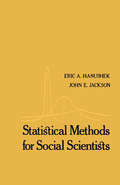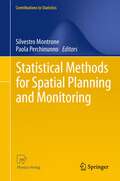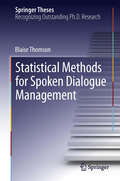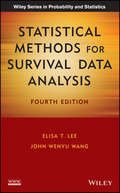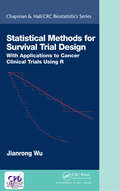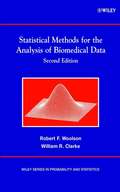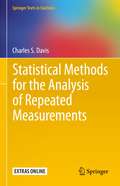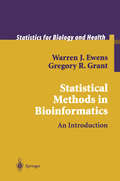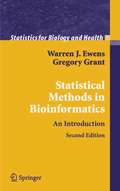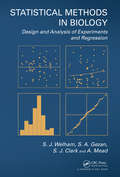- Table View
- List View
Statistical Methods for Reliability Data (Wiley Series in Probability and Statistics #314)
by William Q. Meeker Luis A. EscobarAmstat News asked three review editors to rate their top five favorite books in the September 2003 issue. Statistical Methods for Reliability Data was among those chosen. Bringing statistical methods for reliability testing in line with the computer age This volume presents state-of-the-art, computer-based statistical methods for reliability data analysis and test planning for industrial products. Statistical Methods for Reliability Data updates and improves established techniques as it demonstrates how to apply the new graphical, numerical, or simulation-based methods to a broad range of models encountered in reliability data analysis. It includes methods for planning reliability studies and analyzing degradation data, simulation methods used to complement large-sample asymptotic theory, general likelihood-based methods of handling arbitrarily censored data and truncated data, and more. In this book, engineers and statisticians in industry and academia will find: A wealth of information and procedures developed to give products a competitive edge Simple examples of data analysis computed with the S-PLUS system-for which a suite of functions and commands is available over the Internet End-of-chapter, real-data exercise sets Hundreds of computer graphics illustrating data, results of analyses, and technical concepts An essential resource for practitioners involved in product reliability and design decisions, Statistical Methods for Reliability Data is also an excellent textbook for on-the-job training courses, and for university courses on applied reliability data analysis at the graduate level. An Instructor's Manual presenting detailed solutions to all the problems in the book is available upon requestfrom the Wiley editorial department.
Statistical Methods for Social Scientists
by Eric A Hanushek John E. JacksonThe aspects of this text which we believe are novel, at least in degree, include: an effort to motivate different sections with practical examples and an empirical orientation; an effort to intersperse several easily motivated examples throughout the book and to maintain some continuity in these examples; and the extensive use of Monte Carlo simulations to demonstrate particular aspects of the problems and estimators being considered. In terms of material being presented, the unique aspects include the first chapter which attempts to address the use of empirical methods in the social sciences, the seventh chapter which considers models with discrete dependent variables and unobserved variables. Clearly these last two topics in particular are quite advanced--more advanced than material that is currently available on the subject. These last two topics are also currently experiencing rapid development and are not adequately described in most other texts.
Statistical Methods for Spatial Data Analysis (Chapman & Hall/CRC Texts in Statistical Science)
by Carol A. Gotway Oliver SchabenbergerUnderstanding spatial statistics requires tools from applied and mathematical statistics, linear model theory, regression, time series, and stochastic processes. It also requires a mindset that focuses on the unique characteristics of spatial data and the development of specialized analytical tools designed explicitly for spatial data analysis. Statistical Methods for Spatial Data Analysis answers the demand for a text that incorporates all of these factors by presenting a balanced exposition that explores both the theoretical foundations of the field of spatial statistics as well as practical methods for the analysis of spatial data. This book is a comprehensive and illustrative treatment of basic statistical theory and methods for spatial data analysis, employing a model-based and frequentist approach that emphasizes the spatial domain. It introduces essential tools and approaches including: measures of autocorrelation and their role in data analysis; the background and theoretical framework supporting random fields; the analysis of mapped spatial point patterns; estimation and modeling of the covariance function and semivariogram; a comprehensive treatment of spatial analysis in the spectral domain; and spatial prediction and kriging. The volume also delivers a thorough analysis of spatial regression, providing a detailed development of linear models with uncorrelated errors, linear models with spatially-correlated errors and generalized linear mixed models for spatial data. It succinctly discusses Bayesian hierarchical models and concludes with reviews on simulating random fields, non-stationary covariance, and spatio-temporal processes.Additional material on the CRC Press website supplements the content of this book. The site provides data sets used as examples in the text, software code that can be used to implement many of the principal methods described and illustrated, and updates to the text itself.
Statistical Methods for Spatial Data Analysis (Chapman & Hall/CRC Texts in Statistical Science)
by Oliver Schabenberger Carol A. GotwayUnderstanding spatial statistics requires tools from applied and mathematical statistics, linear model theory, regression, time series, and stochastic processes. It also requires a mindset that focuses on the unique characteristics of spatial data and the development of specialized analytical tools designed explicitly for spatial data analysis. Statistical Methods for Spatial Data Analysis answers the demand for a text that incorporates all of these factors by presenting a balanced exposition that explores both the theoretical foundations of the field of spatial statistics as well as practical methods for the analysis of spatial data. This book is a comprehensive and illustrative treatment of basic statistical theory and methods for spatial data analysis, employing a model-based and frequentist approach that emphasizes the spatial domain. It introduces essential tools and approaches including: measures of autocorrelation and their role in data analysis; the background and theoretical framework supporting random fields; the analysis of mapped spatial point patterns; estimation and modeling of the covariance function and semivariogram; a comprehensive treatment of spatial analysis in the spectral domain; and spatial prediction and kriging. The volume also delivers a thorough analysis of spatial regression, providing a detailed development of linear models with uncorrelated errors, linear models with spatially-correlated errors and generalized linear mixed models for spatial data. It succinctly discusses Bayesian hierarchical models and concludes with reviews on simulating random fields, non-stationary covariance, and spatio-temporal processes.Additional material on the CRC Press website supplements the content of this book. The site provides data sets used as examples in the text, software code that can be used to implement many of the principal methods described and illustrated, and updates to the text itself.
Statistical Methods for Spatial Planning and Monitoring (Contributions to Statistics)
by Silvestro Montrone and Paola PerchinunnoThe book aims to investigate methods and techniques for spatial statistical analysis suitable to model spatial information in support of decision systems. Over the last few years there has been a considerable interest in these tools and in the role they can play in spatial planning and environmental modelling.One of the earliest and most famous definition of spatial planning was “a geographical expression to the economic, social, cultural and ecological policies of society”: borrowing from this point of view, this text shows how an interdisciplinary approach is an effective way to an harmonious integration of national policies with regional and local analysis.A wide range of spatial models and techniques is, also, covered: spatial data mining, point processes analysis, nearest neighbor statistics and cluster detection, Fuzzy Regression model and local indicators of spatial association; all of these tools provide the policy-maker with a valuable support to policy development.
Statistical Methods for Spoken Dialogue Management (Springer Theses)
by Blaise ThomsonSpeech is the most natural mode of communication and yet attempts to build systems which support robust habitable conversations between a human and a machine have so far had only limited success. A key reason is that current systems treat speech input as equivalent to a keyboard or mouse, and behaviour is controlled by predefined scripts that try to anticipate what the user will say and act accordingly. But speech recognisers make many errors and humans are not predictable; the result is systems which are difficult to design and fragile in use.Statistical methods for spoken dialogue management takes a radically different view. It treats dialogue as the problem of inferring a user's intentions based on what is said. The dialogue is modelled as a probabilistic network and the input speech acts are observations that provide evidence for performing Bayesian inference. The result is a system which is much more robust to speech recognition errors and for which a dialogue strategy can be learned automatically using reinforcement learning. The thesis describes both the architecture, the algorithms needed for fast real-time inference over very large networks, model parameter estimation and policy optimisation. This ground-breaking work will be of interest both to practitioners in spoken dialogue systems and to cognitive scientists interested in models of human behaviour.
Statistical Methods for Survival Data Analysis (Wiley Series in Probability and Statistics #Vol. 281)
by Elisa T. Lee John Wenyu WangPraise for the Third Edition “. . . an easy-to read introduction to survival analysis which covers the major concepts and techniques of the subject.” —Statistics in Medical Research Updated and expanded to reflect the latest developments, Statistical Methods for Survival Data Analysis, Fourth Edition continues to deliver a comprehensive introduction to the most commonly-used methods for analyzing survival data. Authored by a uniquely well-qualified author team, the Fourth Edition is a critically acclaimed guide to statistical methods with applications in clinical trials, epidemiology, areas of business, and the social sciences. The book features many real-world examples to illustrate applications within these various fields, although special consideration is given to the study of survival data in biomedical sciences. Emphasizing the latest research and providing the most up-to-date information regarding software applications in the field, Statistical Methods for Survival Data Analysis, Fourth Edition also includes: Marginal and random effect models for analyzing correlated censored or uncensored data Multiple types of two-sample and K-sample comparison analysis Updated treatment of parametric methods for regression model fitting with a new focus on accelerated failure time models Expanded coverage of the Cox proportional hazards model Exercises at the end of each chapter to deepen knowledge of the presented material Statistical Methods for Survival Data Analysis is an ideal text for upper-undergraduate and graduate-level courses on survival data analysis. The book is also an excellent resource for biomedical investigators, statisticians, and epidemiologists, as well as researchers in every field in which the analysis of survival data plays a role.
Statistical Methods for Survival Data Analysis (Wiley Series in Probability and Statistics)
by Elisa T. Lee John Wenyu WangPraise for the Third Edition “. . . an easy-to read introduction to survival analysis which covers the major concepts and techniques of the subject.” —Statistics in Medical Research Updated and expanded to reflect the latest developments, Statistical Methods for Survival Data Analysis, Fourth Edition continues to deliver a comprehensive introduction to the most commonly-used methods for analyzing survival data. Authored by a uniquely well-qualified author team, the Fourth Edition is a critically acclaimed guide to statistical methods with applications in clinical trials, epidemiology, areas of business, and the social sciences. The book features many real-world examples to illustrate applications within these various fields, although special consideration is given to the study of survival data in biomedical sciences. Emphasizing the latest research and providing the most up-to-date information regarding software applications in the field, Statistical Methods for Survival Data Analysis, Fourth Edition also includes: Marginal and random effect models for analyzing correlated censored or uncensored data Multiple types of two-sample and K-sample comparison analysis Updated treatment of parametric methods for regression model fitting with a new focus on accelerated failure time models Expanded coverage of the Cox proportional hazards model Exercises at the end of each chapter to deepen knowledge of the presented material Statistical Methods for Survival Data Analysis is an ideal text for upper-undergraduate and graduate-level courses on survival data analysis. The book is also an excellent resource for biomedical investigators, statisticians, and epidemiologists, as well as researchers in every field in which the analysis of survival data plays a role.
Statistical Methods for Survival Trial Design: With Applications to Cancer Clinical Trials Using R (Chapman & Hall/CRC Biostatistics Series)
by Jianrong WuStatistical Methods for Survival Trial Design: With Applications to Cancer Clinical Trials Using R provides a thorough presentation of the principles of designing and monitoring cancer clinical trials in which time-to-event is the primary endpoint. Traditional cancer trial designs with time-to-event endpoints are often limited to the exponential model or proportional hazards model. In practice, however, those model assumptions may not be satisfied for long-term survival trials. This book is the first to cover comprehensively the many newly developed methodologies for survival trial design, including trial design under the Weibull survival models; extensions of the sample size calculations under the proportional hazard models; and trial design under mixture cure models, complex survival models, Cox regression models, and competing-risk models. A general sequential procedure based on the sequential conditional probability ratio test is also implemented for survival trial monitoring. All methodologies are presented with sufficient detail for interested researchers or graduate students.
Statistical Methods for Survival Trial Design: With Applications to Cancer Clinical Trials Using R (Chapman & Hall/CRC Biostatistics Series)
by Jianrong WuStatistical Methods for Survival Trial Design: With Applications to Cancer Clinical Trials Using R provides a thorough presentation of the principles of designing and monitoring cancer clinical trials in which time-to-event is the primary endpoint. Traditional cancer trial designs with time-to-event endpoints are often limited to the exponential model or proportional hazards model. In practice, however, those model assumptions may not be satisfied for long-term survival trials. This book is the first to cover comprehensively the many newly developed methodologies for survival trial design, including trial design under the Weibull survival models; extensions of the sample size calculations under the proportional hazard models; and trial design under mixture cure models, complex survival models, Cox regression models, and competing-risk models. A general sequential procedure based on the sequential conditional probability ratio test is also implemented for survival trial monitoring. All methodologies are presented with sufficient detail for interested researchers or graduate students.
Statistical Methods for the Analysis of Biomedical Data (Wiley Series in Probability and Statistics #371)
by Robert F. Woolson William R. ClarkeThe new edition adds a chapter on multiple linear regression in biomedical research, with sections including the multiple linear regressions model and least squares; the ANOVA table, parameter estimates, and confidence intervals; partial f-tests; polynomial regression; and analysis of covariance. * Organized by problem rather than method, so it guides readers to the correct technique for solving the problem at hand.
Statistical Methods for the Analysis of Repeated Measurements (Springer Texts in Statistics)
by Charles S. DavisA comprehensive introduction to a wide variety of statistical methods for the analysis of repeated measurements. It is designed to be both a useful reference for practitioners and a textbook for a graduate-level course focused on methods for the analysis of repeated measurements. The important features of this book include a comprehensive coverage of classical and recent methods for continuous and categorical outcome variables; numerous homework problems at the end of each chapter; and the extensive use of real data sets in examples and homework problems.
Statistical Methods for the Assessment of Point Source Pollution: Proceedings of a Workshop on Statistical Methods for the Assessment of Point Source Pollution, held in Burlington, Ontario, Canada
by D. T. Chapman A. H. El-ShaarawiThis book contains the proceedings of a workshop, 'Statistical Methods for the Assess ment of Point Source Pollution', held September 12-14, 1988, at the Canada Centre for Inland Waters in Burlington, Ontario, Canada. The objectives of the workshop were to: a) advance the art, science, and application of statistical methods to current water quality issues by stimulating discussions and disseminating ideas and information. The emphasis was on statistical problems associated with monitor ing and controlling discharges from industries and municipalities and assessing the impact of these discharges on receiving water quality, b) provide a forum for managers, engineers, scientists, and statisticians to present and discuss techniques for evaluating water quality data and planning monitoring activities, c) provide a published state-of-the art summary of the application of statistical methods for the assessment of point source discharges and their impact on water qUality. The papers contained in this volume cover a number of topics that are of concern not only for monitoring and assessing point source pollution but also for other environmental problems.
Statistical Methods for the Evaluation of Educational Services and Quality of Products (Contributions to Statistics)
by Paola Monari Matilde Bini Domenico Piccolo Luigi SalmasoThe book presents statistical methods and models that can usefully support the ev- uation of educational services and quality of products. The contributions collected in this book summarize the work of several researchers from the universities of Bologna, Firenze, Napoli and Padova. The contributions are written with a cons- tent notation and a uni?ed view, and concern methodological advances developed mostly with reference to speci?c problems of evaluation using real data sets. The evaluation of educational services, as well as the analysis of judgements and preferences, poses severe methodological challenges because of the presence of one or more of the following aspects: the observational (non experimental) nature of the context, which is associated with the well-known problems of selection bias and presence of nuisance factors; the hierarchical structure of the data, that entails c- related observations and consideration of effects at different levels of the hierarchy and their interactions (multilevel analysis); the multivariate and qualitative nature of the dependent variable, that requires the use of ad hoc statistical methodologies; the presence of non observable factors, e. g. the satisfaction, calling for the use of latent variables models; the simultaneous presence of components of pleasure and components of uncertainty in the explication of the judgments, that asks for the speci?cation and estimation of mixture models. The ?rst part of the book deals with latent variable models.
Statistical Methods for the Evaluation of University Systems (Contributions to Statistics)
by Massimo Attanasio and Vincenza CapursiThis book presents a collection of statistical methods and procedures to assess data coming from educational systems. The topics examined include: statistical methods for constructing composite indicators, applied measurements, assessment of educational systems, measurement of the performance of the students at Italian universities, and statistical modeling for questionnaire data. Other issues are the implications of introducing different assessment criteria and procedures to the Italian university system.
Statistical Methods for the Social and Behavioural Sciences: A Model-Based Approach
by David B. FloraStatistical methods in modern research increasingly entail developing, estimating and testing models for data. Rather than rigid methods of data analysis, the need today is for more flexible methods for modelling data. In this logical, easy-to-follow and exceptionally clear book, David Flora provides a comprehensive survey of the major statistical procedures currently used. His innovative model-based approach teaches you how to: Understand and choose the right statistical model to fit your data Match substantive theory and statistical models Apply statistical procedures hands-on, with example data analyses Develop and use graphs to understand data and fit models to data Work with statistical modeling principles using any software package Learn by applying, with input and output files for R, SAS, SPSS, and Mplus. Statistical Methods for the Social and Behavioural Sciences: A Model Based Approach is the essential guide for those looking to extend their understanding of the principles of statistics, and begin using the right statistical modeling method for their own data. It is particularly suited to second or advanced courses in statistical methods across the social and behavioural sciences.
Statistical Methods for the Social and Behavioural Sciences: A Model-Based Approach
by David B. FloraStatistical methods in modern research increasingly entail developing, estimating and testing models for data. Rather than rigid methods of data analysis, the need today is for more flexible methods for modelling data. In this logical, easy-to-follow and exceptionally clear book, David Flora provides a comprehensive survey of the major statistical procedures currently used. His innovative model-based approach teaches you how to: Understand and choose the right statistical model to fit your data Match substantive theory and statistical models Apply statistical procedures hands-on, with example data analyses Develop and use graphs to understand data and fit models to data Work with statistical modeling principles using any software package Learn by applying, with input and output files for R, SAS, SPSS, and Mplus. Statistical Methods for the Social and Behavioural Sciences: A Model Based Approach is the essential guide for those looking to extend their understanding of the principles of statistics, and begin using the right statistical modeling method for their own data. It is particularly suited to second or advanced courses in statistical methods across the social and behavioural sciences.
Statistical Methods for Trend Detection and Analysis in the Environmental Sciences
by Richard Chandler Marian ScottThe need to understand and quantify change is fundamental throughout the environmental sciences. This might involve describing past variation, understanding the mechanisms underlying observed changes, making projections of possible future change, or monitoring the effect of intervening in some environmental system. This book provides an overview of modern statistical techniques that may be relevant in problems of this nature. Practitioners studying environmental change will be familiar with many classical statistical procedures for the detection and estimation of trends. However, the ever increasing capacity to collect and process vast amounts of environmental information has led to growing awareness that such procedures are limited in the insights that they can deliver. At the same time, significant developments in statistical methodology have often been widely dispersed in the statistical literature and have therefore received limited exposure in the environmental science community. This book aims to provide a thorough but accessible review of these developments. It is split into two parts: the first provides an introduction to this area and the second part presents a collection of case studies illustrating the practical application of modern statistical approaches to the analysis of trends in real studies. Key Features: Presents a thorough introduction to the practical application and methodology of trend analysis in environmental science. Explores non-parametric estimation and testing as well as parametric techniques. Methods are illustrated using case studies from a variety of environmental application areas. Looks at trends in all aspects of a process including mean, percentiles and extremes. Supported by an accompanying website featuring datasets and R code. The book is designed to be accessible to readers with some basic statistical training, but also contains sufficient detail to serve as a reference for practising statisticians. It will therefore be of use to postgraduate students and researchers both in the environmental sciences and in statistics.
Statistical Methods: The Geometric Approach (Springer Texts in Statistics)
by David J. Saville Graham R. WoodA novel exposition of the analysis of variance and regression. The key feature here is that these tools are viewed in their natural mathematical setting - the geometry of finite dimensions. This is because geometry clarifies the basic statistics and unifies the many aspects of analysing variance and regression.
Statistical Methods in Agriculture and Experimental Biology
by Roger MeadThe third edition of this popular introductory text maintains the character that won worldwide respect for its predecessors but features a number of enhancements that broaden its scope, increase its utility, and bring the treatment thoroughly up to date. It provides complete coverage of the statistical ideas and methods essential to students in agriculture or experimental biology. In addition to covering fundamental methodology, this treatment also includes more advanced topics that the authors believe help develop an appreciation of the breadth of statistical methodology now available. The emphasis is not on mathematical detail, but on ensuring students understand why and when various methods should be used.New in the Third Edition:A chapter on the two simplest yet most important methods of multivariate analysisIncreased emphasis on modern computer applications Discussions on a wider range of data types and the graphical display of dataAnalysis of mixed cropping experiments and on-farm experiments
Statistical Methods in Agriculture and Experimental Biology (Texts In Statistical Science Ser.)
by Roger MeadThe third edition of this popular introductory text maintains the character that won worldwide respect for its predecessors but features a number of enhancements that broaden its scope, increase its utility, and bring the treatment thoroughly up to date. It provides complete coverage of the statistical ideas and methods essential to students in agriculture or experimental biology. In addition to covering fundamental methodology, this treatment also includes more advanced topics that the authors believe help develop an appreciation of the breadth of statistical methodology now available. The emphasis is not on mathematical detail, but on ensuring students understand why and when various methods should be used.New in the Third Edition:A chapter on the two simplest yet most important methods of multivariate analysisIncreased emphasis on modern computer applications Discussions on a wider range of data types and the graphical display of dataAnalysis of mixed cropping experiments and on-farm experiments
Statistical Methods in Bioinformatics: An Introduction (Statistics for Biology and Health)
by Warren J. Ewens Gregory R. GrantThere was a real need for a book that introduces statistics and probability as they apply to bioinformatics. This book presents an accessible introduction to elementary probability and statistics and describes the main statistical applications in the field.
Statistical Methods in Bioinformatics: An Introduction (Statistics for Biology and Health)
by Warren J. Ewens Gregory R. GrantAdvances in computers and biotechnology have had a profound impact on biomedical research, and as a result complex data sets can now be generated to address extremely complex biological questions. Correspondingly, advances in the statistical methods necessary to analyze such data are following closely behind the advances in data generation methods. The statistical methods required by bioinformatics present many new and difficult problems for the research community. This book provides an introduction to some of these new methods. The main biological topics treated include sequence analysis, BLAST, microarray analysis, gene finding, and the analysis of evolutionary processes. The main statistical techniques covered include hypothesis testing and estimation, Poisson processes, Markov models and Hidden Markov models, and multiple testing methods. The second edition features new chapters on microarray analysis and on statistical inference, including a discussion of ANOVA, and discussions of the statistical theory of motifs and methods based on the hypergeometric distribution. Much material has been clarified and reorganized. The book is written so as to appeal to biologists and computer scientists who wish to know more about the statistical methods of the field, as well as to trained statisticians who wish to become involved with bioinformatics. The earlier chapters introduce the concepts of probability and statistics at an elementary level, but with an emphasis on material relevant to later chapters and often not covered in standard introductory texts. Later chapters should be immediately accessible to the trained statistician. Sufficient mathematical background consists of introductory courses in calculus and linear algebra. The basic biological concepts that are used are explained, or can be understood from the context, and standard mathematical concepts are summarized in an Appendix. Problems are provided at the end of each chapter allowing the reader to develop aspects of the theory outlined in the main text. Warren J. Ewens holds the Christopher H. Brown Distinguished Professorship at the University of Pennsylvania. He is the author of two books, Population Genetics and Mathematical Population Genetics. He is a senior editor of Annals of Human Genetics and has served on the editorial boards of Theoretical Population Biology, GENETICS, Proceedings of the Royal Society B and SIAM Journal in Mathematical Biology. He is a fellow of the Royal Society and the Australian Academy of Science. Gregory R. Grant is a senior bioinformatics researcher in the University of Pennsylvania Computational Biology and Informatics Laboratory. He obtained his Ph.D. in number theory from the University of Maryland in 1995 and his Masters in Computer Science from the University of Pennsylvania in 1999. Comments on the first edition: "This book would be an ideal text for a postgraduate course…[and] is equally well suited to individual study…. I would recommend the book highly." (Biometrics) "Ewens and Grant have given us a very welcome introduction to what is behind those pretty [graphical user] interfaces." (Naturwissenschaften) "The authors do an excellent job of presenting the essence of the material without getting bogged down in mathematical details." (Journal American Statistical Association) "The authors have restructured classical material to a great extent and the new organization of the different topics is one of the outstanding services of the book." (Metrika)
Statistical Methods in Biology: Design and Analysis of Experiments and Regression
by S. J. WelhamWritten in simple language with relevant examples, Statistical Methods in Biology: Design and Analysis of Experiments and Regression is a practical and illustrative guide to the design of experiments and data analysis in the biological and agricultural sciences. The book presents statistical ideas in the context of biological and agricultural scien

